The Avendaño brothers

The Avendaño brothers
October 7, 2009 TRAIL TO THE WINTER PASTURES

I met Jose and Amando one autumn day, when the yellow leaves of the poplars begin to fall. An icy wind was blowing. These two brothers from Ayora, who were 42 and 48 years old in 2010, respectively, had a herd of two thousand white mountain goats. They spent the summer in pastures in the Requena area, in the Herrada del Gallego area. When autumn arrived, they migrated to the Sierra de Dos Aguas and Tous1, where they spent the winter.

A month before the autumn trail, Jose left with a herd of four hundred goats, which were about to give birth, along with a few males. Just a month later, when the cold began to become unbearable and the first frosts appeared, Amando did it with the rest of the herd.
We left early in the morning and soon with the first rays of sun, nature offered us a spectacular gift, the bellowing of the deer, which with their bellows resounding throughout the mountains challenged their rivals to dispute the females. These sounds, which were always produced with the first autumn rains, marked the departure of the herds in transhumance towards the more benign areas of Dos Aguas and Tous.

Crossing the Sierra de Martés and after having walked for about two hours, we entered a valley where fields of almond trees, olive trees and vineyards abounded. A dreamlike landscape appeared before us, we saw on the slopes of the mountains the red blanket of the leaves of the vineyards, a true autumn landscape. We were in the division of several districts: Cortes de Pallás, El Oro and Venta Gaeta. In these parts and specifically in the Muela del Oro we ran into the shepherd Jaime del Valle Robledo, a native of the village of Oro but who lived in Dos Aguas. We chatted with him for a long time. He told us that he was about to retire and that he still took the sheep out every day in this area. He told us how bad everything is going and how little consideration politicians have for the job.
“Very poor quality lambs and sheep enter Spain at a ridiculous price and we have to “lower our pants”, selling top quality meat at the price of all this rubbish…”
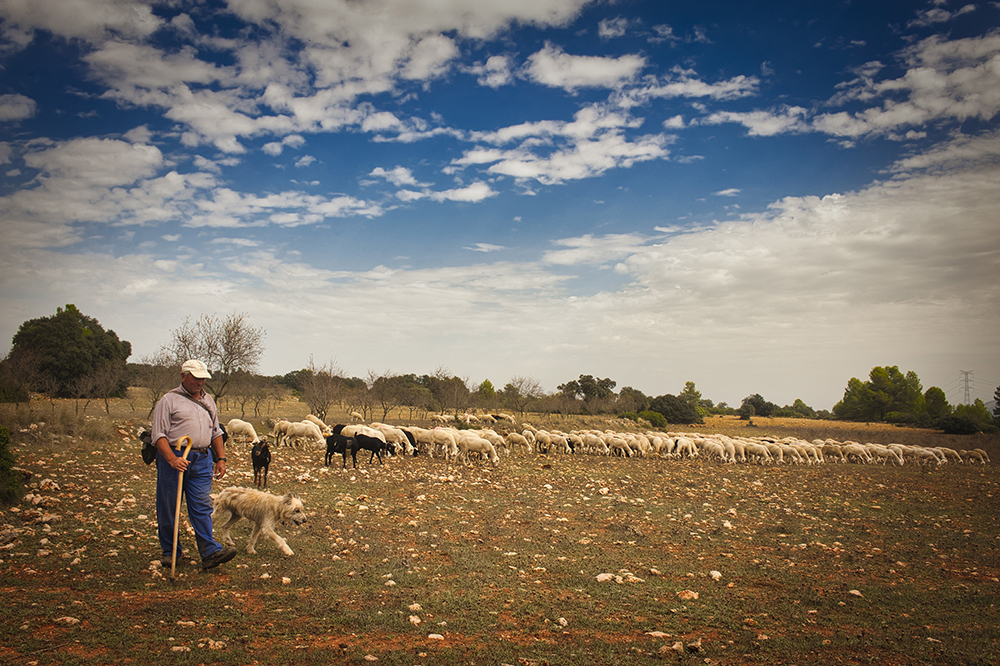
We said goodbye to this good man and already in the village of Oro we made a stop along the way to eat. Amando resuming the conversation said:
“When the few remaining shepherds finish, everything will end there. Twenty years ago I did earn money, now the subsidies are minimal and with what I pay for the auction of the pastures, the feed, the veterinarian and the expenses of the car, bearing in mind that I charge less than half what I used to for lamb I have almost nothing left”
We set off again seeing the nearby Sierra del Ave and El Caballón, in the mountains the garrofero and the albaida begin to abound, a sign that we were passing to a warmer area, points out the shepherd.
There are many finches and thrushes that we see fluttering among the pines. Further on, flocks of wood pigeons and solitary jays crossed our path. But it is the woodpecker that caught our attention, due to its olive green color on the body and red head.
“Si el carpintero canta en la umbría, agua otro día”, it says Amando.
We also see a grajo fly: “Cuando el grajo vuela bajo, hace un frío del carajo, y si vuela a trompicones hace un frío de cojones.”
Amando affirms that in the Sierra de Tous he sees them in the holes in the belts, where they make their nest.

After two days of pilgrimage we finally arrived at the Sierra de Dos Aguas, seeing the town of Millares from a steep belt in the distance, there is a saying around here that says:
“Si quieres ver lugares te asomas a La Ceja y verás la ciudad de Millares”
And that is exactly what we do.
We had reached the winter pastures.
1 Path made by the Avendaño brothers: Herrada del Gallego-through the valley they cross the river Magro-they cross the Sierra de Martés-path through Cortes de Pallás and the village of Oro-Sierra del Ave and Caballón-Dos Aguas-Tous.
On June 25 they leave for Requena and on November 11 they return to Tous.

JANUARY 23, 2010 WINTER PASTURES. TOUS MOUNTAINS
Rainy and foggy winter morning. The goats were found near the impressive gorges carved out by the Júcar River, which makes its way through these colossal mountains forming spectacular vertical walls up to four hundred meters high. The place is grandiose and desolate. Here there are many ravines, springs, shelters, caves and chasms. This is the setting where the herds of the Avendaño brothers will spend the winter, until the arrival of spring where, like every year, they will return to the summer pastures in Requena.
The mountain now in the month of January is full of esparto grass. Jose takes the opportunity to cut a few and shows me how to braid. With this plant it makes waves to throw stones, a method used by ancient shepherds to control the flock. He also makes bottle covers, he carries one himself in his bag.
“El esparto con la menguante de enero, que dura como el hierro” Jose says, implying that it is at this time when he has to cut himself.

As we walk calmly along the path that leads away from the riverbed, we look for some nearby hills…Jose continues telling me curiosities that he had heard from his father and grandfather:
“In the past, when the children were teething and would not stop crying, their grandparents’ remedy consisted of capturing a large snake whose tongue was ripped out, letting it escape alive, with it they hung it around the child’s neck and he I stopped crying.”
About the ophidians he continues saying that:
“The only really dangerous snake due to its powerful venom is the viper, it is very common for this snake to attack cattle, once one of them even killed his dog because it stuck its fangs into his tongue, the poison passed very quickly to the blood and the animal soon died in terrible convulsions. However, the green snake imposes due to its enormous size and aggressiveness, especially when it is in heat it gives very strong tail swipes, but it is not as poisonous.”

He tells me a remedy for pneumonia that he had heard from the elders:
“The liver of a male fox sacrificed with the waning moon of January, is put on the fire to dry, it is minced and mixed with the milk.”
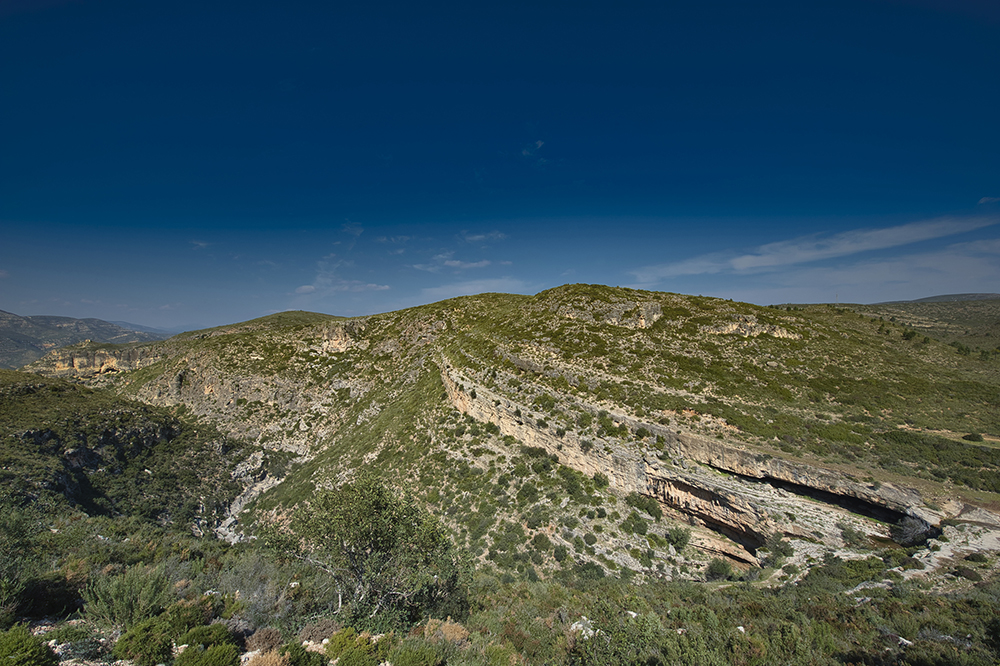
We arrived almost at night at the cave of Pertecates, a refuge for shepherds and cattle. The path of La Laguna passes right through there. Next to the Royal Animal Watering Hole, we stop to rest for a while, while at the bottom of the valley we listen to the voice of the funereal tawny owl, a nocturnal bird of prey. At our feet is the impressive cliff and opposite, in the background, in a hole in the mountain, the Cueva de las Golondrinas…
January 27, 2010 WINTER PASTURES. TOUS MOUNTAINS
Very cold morning as usual this winter. We walk along the “Cabezón del Mellao” that runs downhill looking for the Júcar river, where cattle used to cross the river with a boat. We hear and also see the rooks and Jose remembers that “when the rook flies low it’s cold as hell”, and the snow, although little, begins to fall. The road and the solitude of these mountains invite you to think and above all, I spend a lot of time talking with the shepherd, an episode of his life comes to mind, where a terrible storm surprised him, grazing with his cattle in the Sierra de Dos Aguas:
“I couldn’t see two feet due to the thick fog. A few meters from where he was walking, an enormous lightning struck that made the earth tremble, jumping the stones into the air. The thunder that followed the lightning almost left me deaf. I was very scared.”

Jose was very lucky, the one that a shepherd from Ayora lacked, uncle of Jose Vicente Ortiz (the last shepherd of Caroig), this man after a hard life in the desolate mountains with his flock, a lightning split him in two , killed him, destroyed him along with a dozen sheep, during a terrible and violent storm that broke out in the mountains. It all happened in 1944 on the Collaos estate, bordering Almansa.
At our feet we see the Júcar river flow by, and opposite, on the other side of the river, Jose points out to me the cave where in 1994 a shepherd and his entire herd also died, which was surprised by a fire of great magnitude in the saw. Fleeing from the fire, he chose the wrong direction, instead of looking for the river, he went into the cave, dying asphyxiated along with his sheep.
We make a stop along the way to have lunch, “shepherd’s bread” made the night before at the fire in the country house in his corral. Meanwhile Jose does not stop telling me things:
“My father killed snakes and lizards to eat, I was a child at that time and I remember that I liked that meat.”
He loves the mountains and its animals, they are his life and he respects them:
Every year, in a farmhouse where I spend the summer, some swallows breed inside the house. They have become so accustomed to me that they perch indifferently on top of the chairs.”
He is a great lover of nature. At the end of our lunch, he takes out a bag and deposits all the garbage, while complaining bitterly about all the people who dirty the forest.

We start the march, the mist comes down from the mountains. Our shepherd hastens to say: “It’s going to snow” and pointing to Caroig peak says that it is already snowing there. The night before had been very cold and I already knew that today there would be a storm. I had seen the weather report on television that said that at noon a polar front was entering from the north. But Jose, in the mountains, doesn’t need to watch TV. He tells me: “See those eyebrows? There, it is already snowing.” Returning to the barn and with the last lights, we hear the eagle owl sing near the rock, it is now on the cold nights of January when it is heard the most, since it is the mating season of this nocturnal bird.
January 31, 2010 WINTER PASTURES. TOUS MOUNTAINS

The cold was almost unbearable and the easterly wind raged insolently, without a doubt winter was making itself felt in Ribera. We had arranged to meet at the gas station in Catadau, where a man would pick us up with his 4X4, so that we could access the high and steep mountain. So it happened, almost without delay Antonio approached us who, already retired, spent long periods with Jose, both shared a house in Dos Aguas and the same passion for the mountains and cattle. We got into the car, full of belongings typical of life in the mountains, and nothing prepared for urban comfort, but with enormous strength to step on hills. After a long stretch and constant ups and downs, we saw the figure of Jose at the top of a hill, on his right arm the silent one, and, to his right and left, his two shepherd dogs accompanied him. He welcomed us in a very kind way, without a doubt the mountain taught him to welcome those who arrive. Jose, a man from the mountains, knows how to give the best of himself to the visitor, which is normal in the wild environment, however, this logic is broken when someone needs help in the city. He greeted us with a strong handshake, his trust and friendship were in it, but soon, without delay, he went on to give salt to the goats. Antonio in the car had loaded some sacks of salt and some groceries for Jose. The animals missed our presence and behaved as they would never do with their owner: “today they are crazy” -said Jose-, “also it is very windy, I am going to put them in the fold” -he added-. We went down to the corral, where Antonio prepared an edifying fire for us, it seemed that there was nothing in the house, instead what was missing was everything that passes for being superfluous, since at the moment of truth, no detail escaped Jose . The fire made us come to ourselves, and Jose, seeing us crouched with our hands in the fire, laughed…
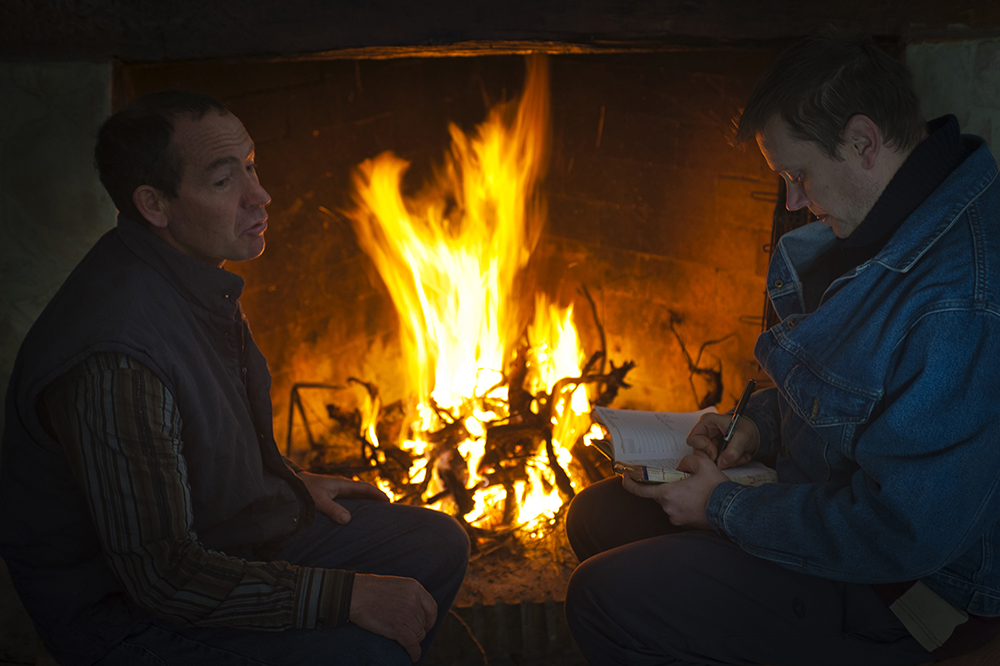
We quickly struck up a conversation and Jose had no secrets: he loved nature, he had grown up in it, because since he was 8 years old he had been taking goats through the mountains. His father, he said, hired a teacher who, being hunchbacked and therefore fleeing from the laughter of the children at school, dedicated himself to teaching Jose and his brothers. He affirms that he knows how to read and write and that he perfected all this in military service; there he learned the multiplication tables so that no one would cheat him in the accounts. Of course, he affirms that everything is very bad and that if he continued like this he would look for another occupation, always linked to the mountain, it is his life and he cannot imagine other benefits, but he would leave aside the cattle.

March 6, 2010 WINTER PASTURES. TOUS MOUNTAINS
Despite being already in the month of March, winter is lengthening and according to the shepherds it is the harshest, longest and coldest in recent years. Gray morning, foggy and of course, very cold, with an icy wind. In front of us is the Caroig peak, completely covered in white. We move accompanying the herd through the ravine of La Curra, an immense furrow between mountains that ends in the Valley of La Laguna, where on its hills to our right and looking north runs an important and old path, which rises in height to stop at Majal de los Palos. Near this place are two of the most important caves in Spain, the Sima del Campillo and the Llenca del Serrano. We stop and Jose points out a gray shrike perched on the tip of a bush branch. We are about 5 km looking east from Los Trillares, where his brother Amando is with a herd of about four hundred goats. I say goodbye to Jose and now I go to meet his brother, after half an hour of walking I find him near the Fuente del Pernil, a place of hills and undulating crests formed by low scrub of gorse, rosemary, palm hearts and heather. In the background and looking west we see the Canillas mountain range, where Jose is now.
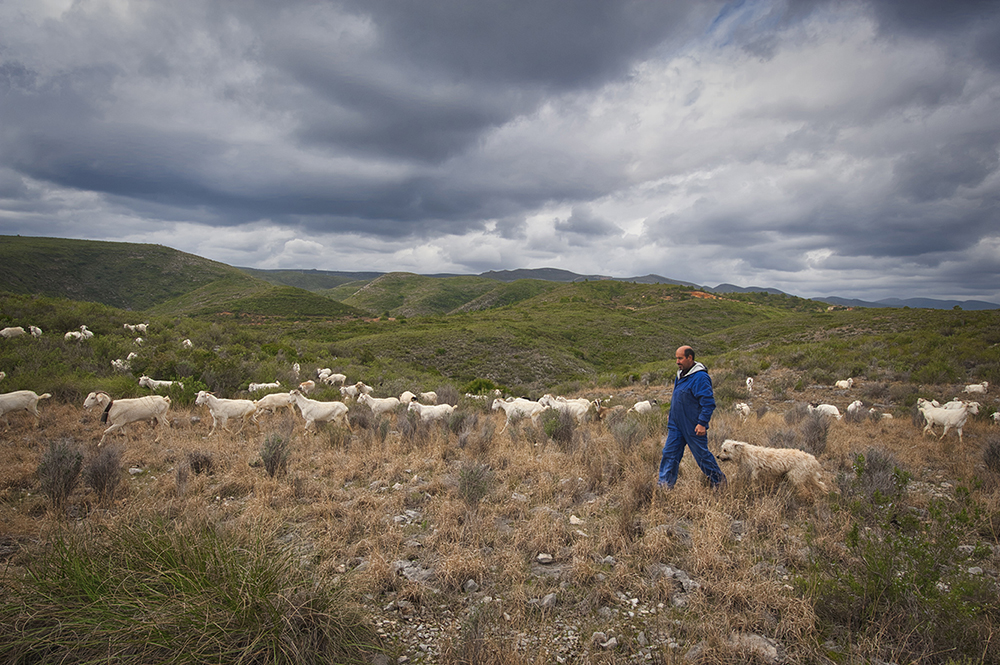
A bird flies low past us and disappears into a field of almond trees. Amando says that it is a cuckoo, it surprises me a lot because it is still cold and this bird usually arrives in migration from the African continent at the end of March, but all these years next to the shepherds have taught me not to doubt their words and I believe it all. It’s a cuckoo.
We are in the mating season of the goats, and it is quite a spectacle to see their bellows, the fights between the males and their persecution of the females: “The strongest will take the trophy, that is nature. ”, says Amando.

In the middle of the afternoon and after meeting his brother, we returned to the barn.
“El pastor vive como los animales, por el día en los matorrales, y por la noche en los corrales”
March 13-14, 2010 WINTER PASTURES. TOUS MOUNTAINS
I arrive at the barn of the Avendaño brothers around 5:00 p.m. Cloudy and cold day (00). While Jose prepares the fire, together with my children I collect Kermes oak roots and rosemary, gorse and vine firewood, bundles of firewood that are piled up at the entrance of the house. These dry branches of Mediterranean bush are perfect for quickly making embers. A good dinner awaits us: freshly made gazpacho cake with vegetables, spices and mountain snail.
The shepherds are practically self-sufficient here in the mountains, apart from guiding and guarding their flocks, they have different animals in their corral: chickens, pigeons, pigs, rabbits… they collect honey from their hives and harvest vegetables in a small orchard.
After preparing the cakes over the fire, we sit by the fire, we have to wait for Amando to come, who is in another corral in the mountains. Meanwhile we talk and Jose tells us stories of ancient shepherds, he tells us about Alonso García Requena nicknamed “Manco de Zarra”, a native of Alcalá del Júcar (Cuenca), who spent his entire life in these mountains, banished from his land for beating to a civil guard. “And that he was one-armed!” José says.
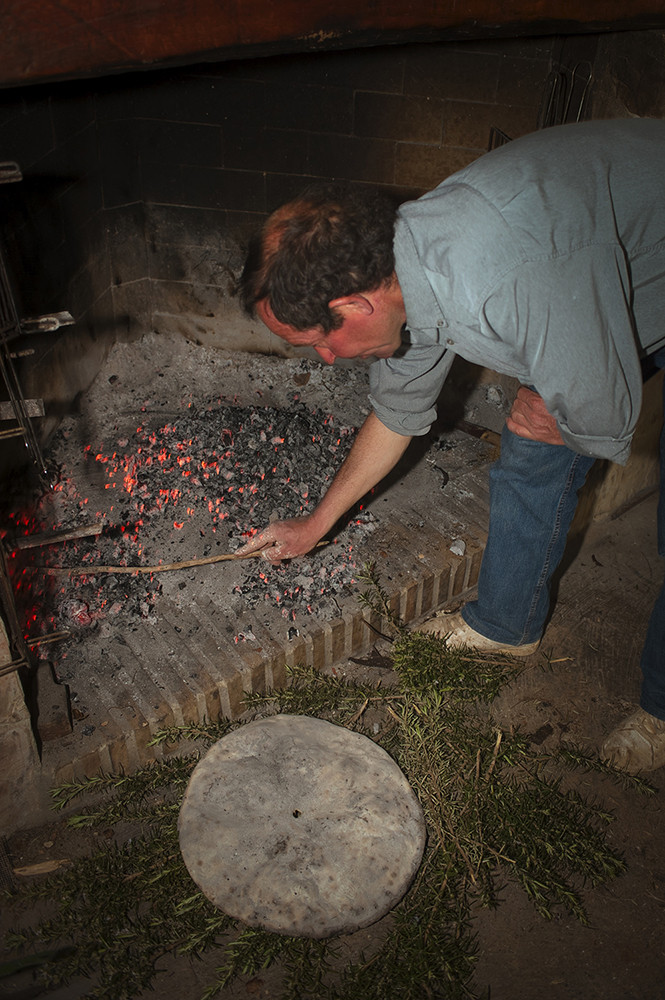
He also relates some experiences of his childhood:
“In my house, my brothers and I, we could not attend school since we lived in the countryside quite far from the population, a teacher who was hunchbacked came to teach us, in exchange my parents fed him and many times he stayed to spend the night, especially in winter…”
Amando arrives late at night, with a new moon, closed and dark as a pitchfork. The corral is nestled in a small valley with garroferos, pine forests and surrounded by belts, except towards its east face. Outside, the cold intensifies and the serenade of the nocturnal birds also begins: we hear the owls singing in the nearby garroferos, the tawny owls do it in the pine forests and in the steep belts it is the eagle owl with its powerful and deep hoot that marks the territory and says who is in charge there. Quite a show for our senses and a unique experience. After dinner we continue talking and he tells an anecdote from 7 years ago when they had to go on a hunt as they used to do with wolves, but this time it was against feral wild dogs, which in several attacks on the herds killed up to 200 sheep. a neighbor of Tous. They cornered them near the cave of Pertecates and killed some right there, those who escaped were reduced and killed a few days later near Millares. Jose remembers that at that time he always went out with the shotgun on his shoulder. The civil guard told the Tous shepherd not to kill the dogs, but that he had to catch them, he replied ironically: “Yes, I’ll catch them, but by the tail.”
The brothers keep reeling off memories:
“During the flood of 19821 all the siblings lived with their parents on the Los Marines farm in Ayora. I (Jose) arrived when I was only 13 years old and I remember that there was a carrot orchard. It was in October of that year when, after the Tous dam broke and flooded the entire region of La Ribera and the Ayora Valley, we remained isolated on the farm, as if on an island. We spent a week eating ham, eggs and orza (sausage, ribs, pork loin, chorizo…). We had fields planted with oats and corn. One day our father told us to go at night to scare away the boars that were approaching the fields. That same night a huge male wild boar ended the life of Manolo, one of the best dogs I had, very noble and hard-working, an animal that at the slightest order from me would look for lost or straggling goats.”

We got up at dawn, to the crowing of the rooster, and after drinking a good glass of freshly milked milk, we got into the Toyota Navajo and went out in search of the herd, which last night had slept very close to the Júcar river canyon. In 20 minutes we arrived at the Pertecates ravine, near the spring we left the SUV, Jose hung up his bag and I my backpack with all the photographic material, and we went out in search of cattle. As soon as he crossed the Pertecates stream, the dog Mariano stayed on display next to some steppe bushes: “He must have seen a toad because the water is close, now is not the time yet for snakes, lizards and geckos” -says the shepherd. I approached stealthily and separated some bushes a few centimeters from the dog’s snout, and indeed, as Jose said, in the shelter of the thicket there were two green toads with a yellow stripe on their backs, they were natterjack toads (Bufo calamita), I photographed them , everything had to be documented, I did not want any detail to escape me, I had proposed that during the long days with the shepherds I had to document all the experiences and sensations that occurred.
We went up the path and after half an hour of walking we reached the point from where we could already see the herd, at the bottom of the ravine. When we got to this place we had to wait for the goats to come up to where we were. They arrive to meet us around 11 am, up there, on the plateau, the herd stops to rest. We, together with the dog Mariano, sat next to some rosemary bushes. The morning sun warms our bodies and the truth is that it is appreciated, because there is a fine, very cold wind. Just a week before the start of spring, winter is reluctant to leave us, the pastor, as he had already pointed out on other occasions, says that this winter has been the hardest in memory in more than 50 years. We see some swallows flying over the herd, “San José is the one who brings them” – says Jose as he watches them. After an hour of sestero, we lead the cattle up the hillside towards the cave of Las Golondrinas, nestled in an almost inaccessible wall and at the very entrance there is a huge fan palm (Chamaerops humilis), “How many storms have you seen fall?” – Jose says, referring to how old this specimen must be. The landscape here is dreamlike, with the impressive Júcar river canyon to our left. Unforgettable moments recorded forever on my retina and recorded for an eternity on the electronic CCD of my camera. After grazing for a while in a green meadow at the foot of the cave, we lead the flock along the path of La Laguna and after crossing the stream at the height of the Pertecates cave, we stop along the way to eat in the shade of a huge Aleppo pine. It is curious to see how here the path splits the mountain range in two just at the point where it crosses the ravine, declared here as a Micro-Reserve of Flora. Looking north to our right, to the shade, we see the slope full of Rodeno pines, while to our left, on the sunny side, the slope is covered with Aleppo pines.
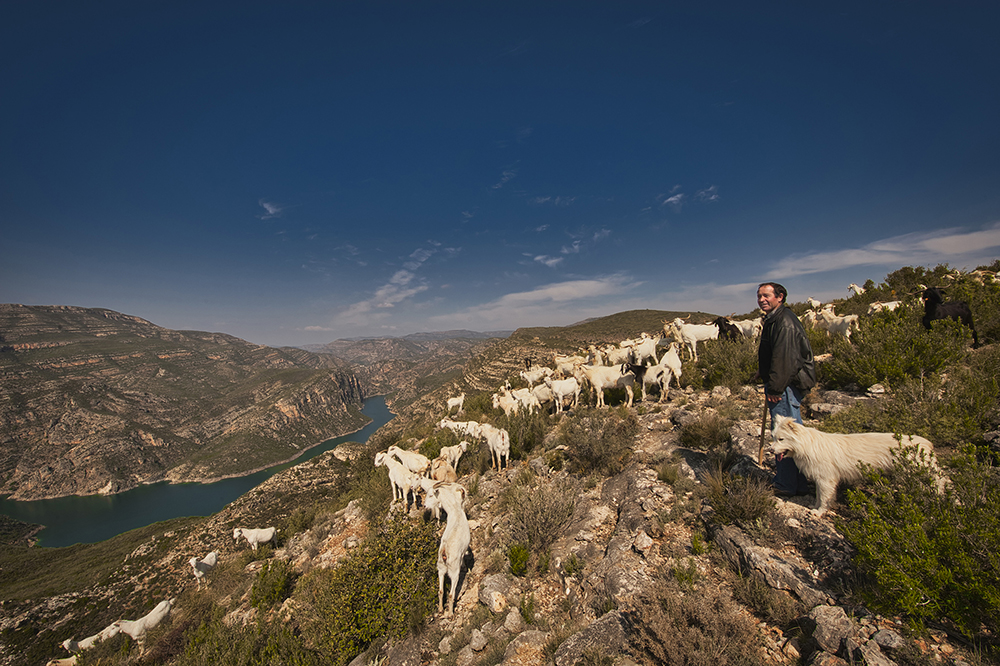
While we eat he tells me about a shepherd from the Sierra de Enguera, Bernardo, a very good person, industrious and hard-working… I tell him that I already had the pleasure of meeting him some time ago when I was on the sidewalk accompanying him, one day when he was moving cattle from the Sierra from Enguera to Alpera.
Later he tells me about Félix Rodríguez de la Fuente and what this famous naturalist has influenced in his life. I tell him that we agree on that and the DVD collection of “El Hombre y la Tierra” shines on our shelves in our homes. Remember that in 1980, when Félix died, it was a year that it rained a lot, the ravines of the mountains were full of water, it was also very cold, specifically the day of his funeral was when it rained more intensely. The good thing about the case is that the next day, reading the newspaper, I see that there is an article that said that yesterday, March 14, the death of Félix was 30 years old. lonely places of Tous.
We start walking along the path of La Laguna to look for the valley with the same name. In front of us, the peak of the Snow and the top of the Tiritario appear majestic, up there there is a very dangerous cave: “the hole can hardly be seen and falls vertically like a well. A long time ago a shepherd measured it and it turned out to be 70 meters. I have lost more than one goat there, including a dog that was killed when it fell”. At the foot of the Tiritario and with the sun hiding behind us through the Sierra de Millares, our day ends.
Jose’s orientation capacity in the mountains is perfect. He himself says: “I have not broken shoes in these places… I, as long as I see the ground I do not get lost, otherwise a day with a lot of fog…”. All this proves it to me, it is capable of finding any utensil that is intentionally left anywhere even if we are crossing the saw in all directions. His sight could be said to be that of a lynx, he sees mountain goats at incredible distances and recognizes birds by their flight and especially by their song…” As a child I was an expert with the slingshot, I had a lot of aim, I entertained myself killing blowflies and horseflies …now everything is video games and strange things…”.
April 5, 2010 WINTER PASTURES. TOUS MOUNTAINS
We arrived at the Cueva de las Alforjas, where more than 40 years ago, during a storm, lightning killed about forty goats. The two shepherds who went with the flock were able to save their lives by being sheltered in the cave, but one of them became deaf.

We are already in spring, even so the day is cold and gray, however we are lucky to hear a bird in the mountains, emissary of good weather, the cuckoo, while a fine and weak rain begins to fall on the mountain. “When the cuckoo sings, it’s soft in the morning and hard in the afternoon” says Jose, referring to the fact that even if it rains in the morning, as the days are already long, by the afternoon everything is already dry. We also heard the blackbird sing, Jose says it is his favorite, he likes to listen to it in the morning when he gets up.

From May 6 to 9, 2010 WINTER PASTURES. TOUS MOUNTAINS
Well into the night I arrive at the Avendaño brothers’ corral. A few days before they had called my mobile to tell me that they had discovered a Bonelli’s eagle nest in the cliffs near the Pico de la Nieve. My intention was to spend the night with the shepherds so that at dawn I could go and photograph the nest. I will never get tired of repeating the kindness with which I am received and, it is seen that they do everything because it is born to them, without expecting or asking for anything in return. They have shown me many times that there in the mountains they are happy and they don’t lack for anything, I realize it, leaving my worries behind and I try to merge into this “universe” of peace, where time seems to stand still, and rush and stress are not well received in these parts.
While Amando finishes outlining some clappers for some sheepskin, his brother serves a delicious rice with bledas and mountain snails at the table, in the center of the table, an onion marinated with the oil from these lands. For dessert, cheese with honey, all homegrown, milk from their goats and honey from the honeycombs they have in the mountains. To finish, an infusion of mountain tea and freshly cut thyme, for digestion.
Outside the wind whistles and we hear the owls sing. Inside, in the warmth of the fire, we talk for a while, but soon sleep overcomes us. The crowing of the rooster wakes us up shortly before dawn. The shepherds prepare their things to go out a new day with the flock, I say goodbye to them and I quickly go to the hiding place that I set up days ago to photograph the eagle. The road to reach the nest site is hard, as there is no path, the place is accessed after having crossed a few hills full of scrub. After a not very long wait I was able to photograph a beautiful specimen of Bonelli’s Eagle feeding the only chick in the nest.
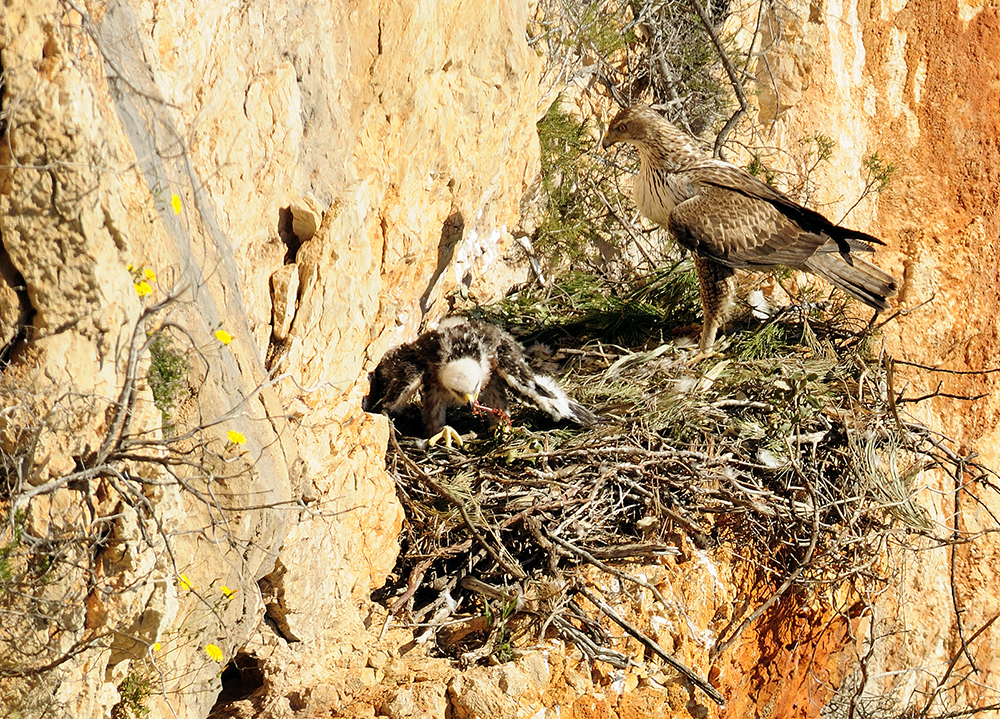
On Sunday of that week I accompanied the herd to the Chol spring, where we stocked up on water, watched closely by a huge lizard that was sunning itself, very close to the path. In the afternoon, already in the corral, Jose prepared us some gazpachos with spring garlic and mountain snails. Then he gave us a demonstration of how he makes cheese with milk milked in the morning.
May 12, 2010 WINTER PASTURES. TOUS MOUNTAINS

We move with the cattle near the chasm of Campillo through the Majalico Blanco, confluence of a series of ravines: Barranco de la Ollica, ravine of Charco Claro, ravine of Romana and ravine of Espliego. Pennyroyal and mountain tea abound in these places. In front of us there are three hills, the Gato hill, the Alforjas hill and the Sima hill. The goats after crossing the Ollica begin to ascend the Loma del Gato. The mountains now in the spring period are covered with a multitude of little flowers, especially one of them white that the shepherd calls “cabrera1”, because they look like herds of cattle. After a long walk of more than 3 hours, we leave the goats alone in the mountains and return to the corral to eat. Eggs, shepherd’s bread, onion, lettuce, milk and honey replenish us after an exhausting morning. In the afternoon we go to a mountain cottage where the shepherds have the sheepskin to prepare them, since it is not long before the cattle are moved from the winter pastures in these mountains to the cooler summer ones in Requena.

Later we will collect honey from the hives:
“Cuando crece el romero, no tiene gozo el colmenero” , referring to the fact that the bees no longer eat.
1 Around this time, the Sierra de Tous is full of white flowers, white flax (Linum suffruticosum L.), popularly known by Cabrera for its resemblance to a herd of white goats.
June 17, 2010 START OF THE TRAIL TO THE SUMMER PASTURES

La Laguna (Tous)—-El Campillo (T)—-La Fontalba (T-Dos Aguas)—-Los dientes de la Vieja (D.A)—-Cueva de la Vieja del Peine (D.A)—-El Caballón de Dos Aguas (D.A)—-La Rápita (D.A)—-La Masía del Collao (D.A)—-Fuente de los Abrevaderos (D.A)—-La Garita (D.A)—-Las Umbrías (D.A)—-La Muela de Dos Aguas (D.A)—-Sierra Martés (Yátova, El Oro and Venta Gaeta)—-Hortolilla (Requena)—-Río Magro (Crossing)—-La Herrada del Gallego (Requena)
We start the trail from the valley of La Laguna and the Campillo area. Pastor Ignacio Millán will also accompany us. We pass through Majalico Blanco where the Sierra del Caballón can be seen in the background. Right there in the Majalico we stop to give the goats salt, and incidentally load four of them in the jeep, since some cannot make the path for various reasons (injuries, miscarriages…). On the way, Jose tells me that in this area of La Laguna and El Campillo there is very good grass.

I realize that the help of the dogs is fundamental, the goats do not always go along the road and they tend to escape through the mountains (they are not like sheep), so the help of the dogs is necessary.
We go up the Pierna Gorda hill (see file 8142 to 8156). Despite the heat, a fresh wind blows on its top. The goats stop for a moment and the bleating and the sound of the cowbells cease. Loneliness takes over the landscape and we only hear the whistle of the wind.
As we follow the path, to our left we see the mountains of Millares and its town, nestled in the mountain in front of us.
Note: for photo captions (files 8158-8159 Loma del Subterráneo de Las Palmeras). There is a cave where shepherds used to take refuge on stormy days.
We continue climbing the Espliego ravine and above the Caballón de la Romana (files 8161-8162), we are met by crossing the path calmly an enormous specimen of Ibex. In the background the Solana de la Fontalba (arch.8173-8188) and the La Moneda pass (arch.8253).

After walking for a period of 3 hours we arrive at the place of Fontalba. We stop to eat at the Canal de Dos Aguas, where some friends are waiting for us at Ramón Carrión’s house (Copete and the retired shepherds Antonio and Herminio).
In the afternoon and with a suffocating heat we crossed the Dientes de La Vieja.

August 15, 2010 SUMMER PASTURES. REQUENA
I arrive early in the morning at the village of La Portera, where I met Jose at the village bar. Despite being in the month of August, it is a cool and choppy day. Jose, while we drink coffee, tells me that it will most likely rain in the afternoon, since he has heard the woodpecker sing in the forest, which he says is the best meteorologist in the world. On the way to the corral we pass by the house-corral of Las Cuevas in the terminus of La Portera, we stop in front of the building that is in ruins, tiles full of moss and adobe walls still define a unique space where cattle were kept, some heaps of straw, animal harness, farm implements, old baskets, sheaves, cobwebs, and dreams. Dressed in the nostalgic beauty of what disappears, he strives to remain standing by offering all that remains: aesthetic beauty, cobwebs and shelter for thrushes and sparrows1. Jose gets a lump in his throat when he sees how everything related to his trade crumbles relentlessly.
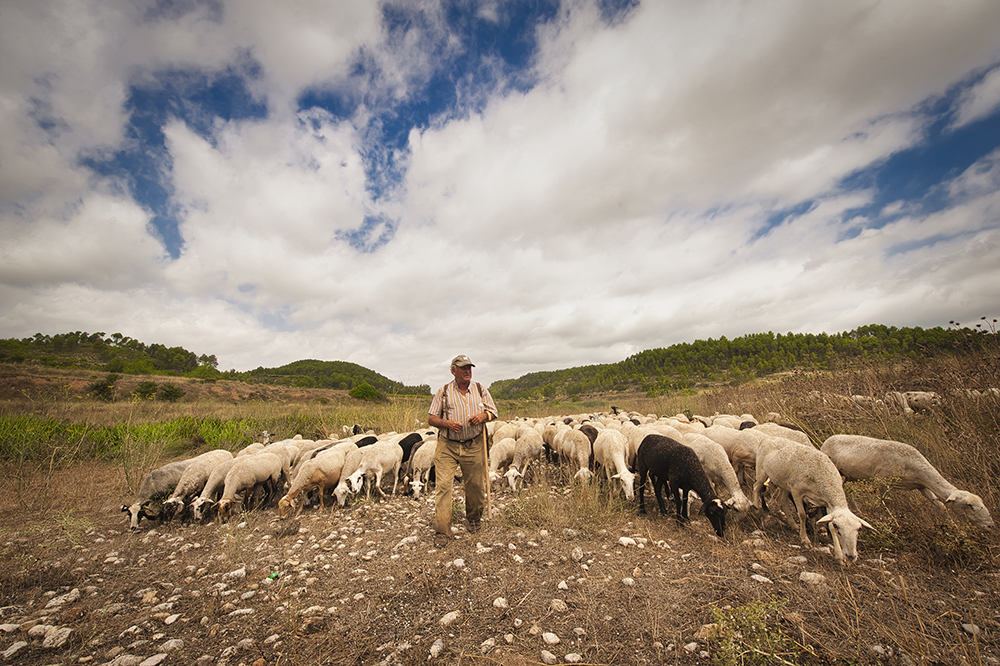
The cattle now graze peacefully in a spectacular spot near the Magro river, there we meet Jaime Martínez and Manuel Pardo, two retirees from Hortunas de Arriba, who are taking care of the orchard. We talk to them and Jaime accompanies us to his house where he shows us his work with esparto grass. Further on and following the course of the river we come across the shepherd Bernardo Pardo, a native of Yátova but who lives in Dos Aguas. Very peculiar man, at 63 years old he continues tied to his cattle. There was a time when he was a cowherd. In his flock he has three meek: Carbonero, Sailor and Volunteer are their names. He is a lively and talkative man, a flamenco singer and a great party animal. At 7 years old he was already working, and at 11 he had to pick up the club out of obligation, “there was nothing to eat” – he says. He always kept the sheep in Yátova and the cows between Dos Aguas and Hortunas.

The shepherds spend many nights in the open during the summer, that is to say, they are on a flock. José, when there is a full moon, loves listening to the sounds of animals, the croaking of toads and frogs, the singing of larks that he says fly in groups at night.
October 2, 2010 SUMMER PASTURES. REQUENA
A few minutes ago the sun began to rise on the summits. Together with Amando I arrive at the corral of La Herrada del Gallego, located on a plateau of Mediterranean scrub, but only a few meters as we go down in altitude, dense forests and deep valleys appear to us. We are at the beginning of October, well into autumn. We start a new grazing day. There are only a few days left for the Avendaño’s cabin to depart on transhumance for the Tous mountains, to spend the winter. The morning is sunny, but late in the afternoon, Amando, pointing to the horizon, tells me that soon there will be a change in the weather, since he sees several “eyes of the sun” (as if they were replicas of the same sun). The truth is that the average temperatures have dropped compared to the past days, and the sun sets a few minutes earlier each day that passes. We see some dense and dark clouds appear over the mountains, we see lightning, followed by the overwhelming burst of thunder, a deep smell of humidity is breathed in the environment and in a few minutes a curtain of water bathes the forest, soaking all the scrub . The temperature has dropped several degrees, the rain stops and the sky clears. A roar sounds in the mountains, another in the valley, the bellowing has begun, the courtship of the deer. The show is impressive, it gets dark and the mountains shake with the bellows. The sky with the sunset that day turns an intense red to give us a beautiful farewell.
1 Cuadernos del Salegar: Roberto Calvo Pérez and Juan José Calvo Pérez
TOUS CASTLE
At noon we set off towards the castle of Tous along some rough paths. The landscape was imposing, wild and desolate mountains. The path led to considerable altitudes to descend later to shady valleys of Rodeno pine. We found small waterfalls and mysterious gorges. Despite being spring, it was a little cold and the tips of our ears turned red. We walked along the stream, and sometimes we saw herds of wild goat grazing the Mediterranean scrub. Above our heads, 6 or 7 sinister crows flew slowly.
We arrive at the plateau, in front of the cave of Las Golondrinas. From here an impressive descent began, through the enormous shady area, covered with mastic and kermes oak that led to a majestic ravine, at the end of which, on top of a steep rock, was the castle of Tous, a short distance away. distance from today due to the fog, gloomy and impressive Júcar canyon.
Great masses of threatening clouds had accumulated. It seemed as if at any moment a storm was going to break out. Directly ahead of us, sinister, emerging from the mist, the castle appeared. Lightning struck, followed by a great clap of thunder.
The sky and the sun were getting dark, although it could not be seen, we assumed that it had already hidden.

It was the last time I saw Jose in these mountains…

